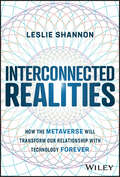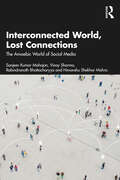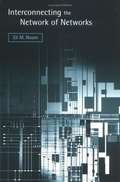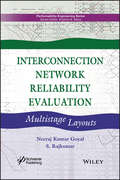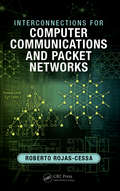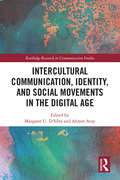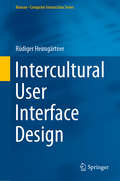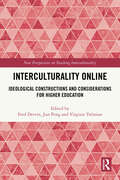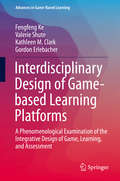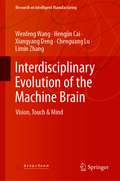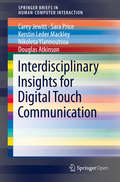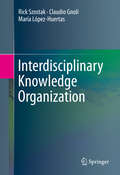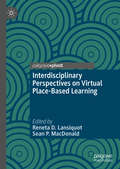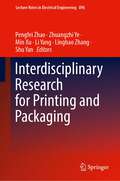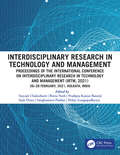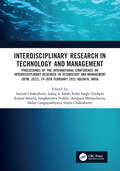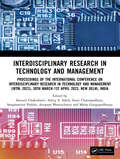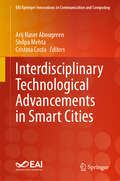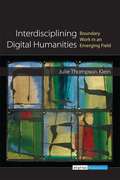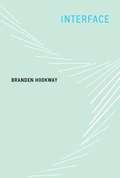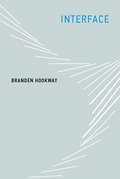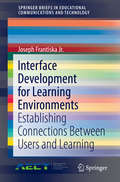- Table View
- List View
Interconnect Reliability in Advanced Memory Device Packaging (Springer Series in Reliability Engineering)
by Chong Leong, Gan Chen-Yu, HuangThis book explains mechanical and thermal reliability for modern memory packaging, considering materials, processes, and manufacturing.In the past 40 years, memory packaging processes have evolved enormously. This book discusses the reliability and technical challenges of first-level interconnect materials, packaging processes, advanced specialty reliability testing, and characterization of interconnects. It also examines the reliability of wire bonding, lead-free solder joints such as reliability testing and data analyses, design for reliability in hybrid packaging and HBM packaging, and failure analyses. The specialty of this book is that the materials covered are not only for second-level interconnects, but also for packaging assembly on first-level interconnects and for the semiconductor back-end on 2.5D and 3D memory interconnects. This book can be used as a text for college and graduate students who have the potential to become our future leaders, scientists, and engineers in the electronics and semiconductor industry.
Interconnected Realities: How the Metaverse Will Transform Our Relationship to Technology Forever
by Leslie ShannonExplore how the metaverse is changing our livesIn Interconnected Realities, Leslie Shannon, Head of Trend and Innovation Scouting at Nokia, delivers an energizing and optimistic new take on the Metaverse. Starting with metaverse realms already in existence today, the book explores the purpose that each independent platform serves, as well as how all these disparate realms will ultimately be stitched together to permanently transform our personal and business lives. A singularly insightful and informed exploration of a fascinating subject at the intersection of technology, business, and society, Interconnected Realities is an essential resource for executives, managers, board members, and other business leaders at companies in a wide range of industries, as well as tech enthusiasts, futurists, and anyone with an interest in the future of social interaction, business, or technology.
Interconnected World, Lost Connections: The Amoebic World of Social Media
by Vinay Sharma Rabindranath Bhattacharyya Sanjeev Kumar Mahajan Himanshu Shekhar MishraThis book offers a comprehensive account of social media as a tool for connecting the world, and how its amoeboid growth pattern has led it to where it is today. Fuelled by rapid advances in communication technologies, social media platforms are gradually revolutionising the way billions of users communicate and share content worldwide on the web. They have become the fulcrum of the interconnected world in the present century. The book articulates a specific theme, beginning with foundational concepts, followed by an in-depth analysis of the current scenario and its associated challenges.This book explores both the promise and the pitfalls of social media. From its role in participatory politics, crowd-sourced crisis response, and cultural promotion to its misuse in everyday life, it examines the expanding impact of social platforms. Through a thought-provoking analysis, it asks: How do we channel this power meaningfully in the age of relentless digital integration? It suggests that the solution is not to disconnect, but to reimagine connection – with responsibility, awareness, and purpose.The book will be specifically valuable for students teachers and practitioners of Communication and Media, Public Policy, Public Administration, Sociology, and General Management.
Interconnecting the Network of Networks
by Eli M. NoamThis book describes the transformation of telecommunications from national network monopolies to a new system, the network of networks, and the glue that holds it together, interconnection.
Interconnection Network Reliability Evaluation: Multistage Layouts (Performability Engineering Series)
by Neeraj Kumar Goyal S. RajkumarKeeping in view the growth of the technological frontiers, there is always a need for the development of reliable, fault tolerant and cost- effective interconnection networks (INs) which are the critical metrics to achieve the goal of parallelism. The main objective of this book is to design new fault tolerant interconnection network layouts capable of path redundancy among dynamic failures. New INs designs are proposed and their observed results are found promising when compared with some of the earlier networks. The book also covers the reliability evaluation of various industrial network topologies considering multiple reliability performance parameters (2-TR, broadcast and ATR). Finally, the book also focuses on reliability evaluation and comparison of various topologies considering connectivity among multiple sources and multiple destinations (MSMT) nodes.
Interconnections for Computer Communications and Packet Networks
by Roberto Rojas-CessaThis book introduces different interconnection networks applied to different systems. Interconnection networks are used to communicate processing units in a multi-processor system, routers in communication networks, and servers in data centers. Queuing techniques are applied to interconnection networks to support a higher utilization of resources. There are different queuing strategies, and these determine not only the performance of the interconnection network, but also the set of requirements to make them work effectively and their cost. Routing algorithms are used to find routes to destinations and directions in what information travels. Additional properties, such as avoiding deadlocks and congestion, are sought. Effective routing algorithms need to be paired up with these networks. The book will introduce the most relevant interconnection networks, queuing strategies, and routing algorithm. It discusses their properties and how these leverage the performance of the whole interconnection system. In addition, the book covers additional topics for memory management and congestion avoidance, used to extract higher performance from the interconnection network.
Intercultural Communication, Identity, and Social Movements in the Digital Age (Routledge Research in Communication Studies)
by Ahmet Atay Margaret U. D’SilvaThis book examines the complex and multidimensional relationship between culture and social media, and its specific impact on issues of identity and social movements, in a globalized world. Contemporary cyber culture involves communication among people who are culturally, nationally, and linguistically similar or radically different. Social media becomes a space for mediated cultural information transfer which can either facilitate a vibrant public sphere or create cultural and social cleavages. Contributors of the book come from diverse cultural backgrounds to provide a comprehensive analysis of how these social media exchanges allow members of traditionally oppressed groups find their voices, cultivate communities, and construct their cultural identities in multiple ways. This book will be of great relevance to scholars and students working in the field of media and new media studies, intercultural communication, especially critical intercultural communication, and academics studying social identity and social movements.
Intercultural Communication, Identity, and Social Movements in the Digital Age (Routledge Research in Communication Studies)
by Margaret U. D’Silva; Ahmet AtayThis book examines the complex and multidimensional relationship between culture and social media, and its specific impact on issues of identity and social movements, in a globalized world. Contemporary cyber culture involves communication among people who are culturally, nationally, and linguistically similar or radically different. Social media becomes a space for mediated cultural information transfer which can either facilitate a vibrant public sphere or create cultural and social cleavages. Contributors of the book come from diverse cultural backgrounds to provide a comprehensive analysis of how these social media exchanges allow members of traditionally oppressed groups find their voices, cultivate communities, and construct their cultural identities in multiple ways.This book will be of great relevance to scholars and students working in the field of media and new media studies, intercultural communication, especially critical intercultural communication, and academics studying social identity and social movements.
Intercultural User Interface Design (Human–Computer Interaction Series)
by Rüdiger HeimgärtnerThe path for developing an internationally usable product with a human-machine interface is described in this textbook, from theory to conception and from design to practical implementation. The most important concepts in the fields of philosophy, communication, culture and Ethnocomputing as the basis of intercultural user interface design are explained. The book presents directly usable and implementable knowledge that is relevant for the processes of internationalization and localization of software. Aspects of software ergonomics, software engineering and human-centered design are presented in an intercultural context; general and concrete recommendations and checklists for immediate use in product design are also provided. Each chapter includes the target message, its motivation and theoretical justification as well as the practical methods to achieve the intended benefit from the respective topic. The book opens with an introduction illuminating the background necessary for taking culture into account in Human Computer Interaction (HCI) design. Definitions of concepts are followed by a historical overview of the importance of taking culture into account in HCI design. Subsequently, the structures, processes, methods, models, and approaches concerning the relationship between culture and HCI design are illustrated to cover the most important questions in practice.
Interculturality Online: Ideological Constructions and Considerations for Higher Education (New Perspectives on Teaching Interculturality)
by Fred Dervin Jun Peng Virginie TrémionThe contested and polysemic concept of ideology has been used only marginally in research on intercultural communication education. This edited volume focuses on the ideological dimensions of online interculturality in higher education, encompassing areas such as telecollaboration, virtual classrooms and online teacher professional development.The chapter authors explore the intercultural engagements, perceptions and experiences of students, teachers and researchers in different parts of the world, including Australia, China, Finland, France, Germany, Indonesia, Japan, Mexico, New Zealand, Spain and the USA. In doing so, they aim to contribute to the current critical and reflexive turn in research and teaching that is examining global socio-economic, political and linguistic inequalities and imbalances of power. Using concrete examples from their own practices, the chapter authors critically and reflexively problematise 'doing' interculturality in higher education by identifying, engaging with, reflecting on and revising ideologies of online interculturality. By intersecting interculturality, technology and ideology, this book also makes a critical contribution to the literature on the internationalisation of higher education and its digitalisation.Written in a globally friendly and engaging style, the book will appeal to academics and students of intercultural communication education in online environments.
Interdisciplinary Approaches to Distance Teaching: Connecting Classrooms in Theory and Practice (Routledge Research in Education)
by Nathan Straight Alan BlackstockSynchronous technologies, particularly interactive video conferencing (IVC), are becoming common modes of teaching and delivering college courses. The increasing popularity of IVC in the U.S. and abroad calls for more pedagogically effective practices for instructors using this technology. This volume focuses on innovative and proven approaches to IVC teaching in a variety of disciplines: English, history, biology, chemistry, geology, engineering, social work, and elementary and special education. Contributors hail from a pioneering university at the forefront of distance education and understand the practice and potential of IVC teaching at the highest levels. Chapters outline the challenges and benefits of IVC teaching from pedagogical, technical, and administrative perspectives.
Interdisciplinary Design of Game-based Learning Platforms: A Phenomenological Examination of the Integrative Design of Game, Learning, and Assessment (Advances in Game-Based Learning)
by Fengfeng Ke Kathleen M. Clark Valerie Shute Gordon ErlebacherThis book represents a four-year research and development project. It presents a phenomenological examination and explanation of a functional design framework for games in education. It furnishes a rich description of the experiences and perceptions of performing interdisciplinary collaborative design among experts of very diverse fields, such as learning systems design, architectural design, assessment design, mathematics education, and scientific computing.
Interdisciplinary Evolution of the Machine Brain: Vision, Touch & Mind (Research on Intelligent Manufacturing)
by Wenfeng Wang Xiangyang Deng Limin Zhang Hengjin Cai Chenguang LuThis book seeks to interpret connections between the machine brain, mind and vision in an alternative way and promote future research into the Interdisciplinary Evolution of Machine Brain (IEMB). It gathers novel research on IEMB, and offers readers a step-by-step introduction to the theory and algorithms involved, including data-driven approaches in machine learning, monitoring and understanding visual environments, using process-based perception to expand insights, mechanical manufacturing for remote sensing, reconciled connections between the machine brain, mind and vision, and the interdisciplinary evolution of machine intelligence. This book is intended for researchers, graduate students and engineers in the fields of robotics, Artificial Intelligence and brain science, as well as anyone who wishes to learn the core theory, principles, methods, algorithms, and applications of IEMB.
Interdisciplinary Insights for Digital Touch Communication (Human–Computer Interaction Series)
by Carey Jewitt Sara Price Nikoleta Yiannoutsou Douglas Atkinson Kerstin Leder MackleyCommunication is increasingly moving beyond ‘ways of seeing’ to ‘ways of feeling’. This Open Access book provides social design insights and implications for HCI research and design exploring digitally mediated touch communication. It offers a socially orientated map to help navigate the complex social landscape of digitally mediated touch for communication: from everyday touch-screens, tangibles, wearables, haptics for virtual reality, to the tactile internet of skin. Drawing on literature reviews, new case-study vignettes, and exemplars of digital touch, the book examines the major social debates provoked by digital touch, and investigates social themes central to the communicative potential and societal consequences of digital touch: · Communication environments, capacities and practices · Norms associations and expectations · Presence, absence and connection · Social imaginaries of digital touch · Digital touch ethics and values The book concludes with a discussion of the significance of social understanding and methods in the context of Interdisciplinary collaborations to explore touch, towards the design of digital touch communication, ‘ways of feeling’, that are useable, appropriate, ethical and socially aware.
Interdisciplinary Knowledge Organization
by Rick Szostak Claudio Gnoli María López-HuertasThis book proposes a novel approach to classification, discusses its myriad advantages, and outlines how such an approach to classification can best be pursued. It encourages a collaborative effort toward the detailed development of such a classification. This book is motivated by the increased importance of interdisciplinary scholarship in the academy, and the widely perceived shortcomings of existing knowledge organization schemes in serving interdisciplinary scholarship. It is designed for scholars of classification research, knowledge organization, the digital environment, and interdisciplinarity itself. The approach recommended blends a general classification with domain-specific classification practices. The book reaches a set of very strong conclusions: -Existing classification systems serve interdisciplinary research and teaching poorly. -A novel approach to classification, grounded in the phenomena studied rather than disciplines, would serve interdisciplinary scholarship much better. It would also have advantages for disciplinary scholarship. The productivity of scholarship would thus be increased. -This novel approach is entirely feasible. Various concerns that might be raised can each be addressed. The broad outlines of what a new classification would look like are developed. -This new approach might serve as a complement to or a substitute for existing classification systems. -Domain analysis can and should be employed in the pursuit of a general classification. This will be particularly important with respect to interdisciplinary domains. -Though the impetus for this novel approach comes from interdisciplinarity, it is also better suited to the needs of the Semantic Web, and a digital environment more generally. Though the primary focus of the book is on classification systems, most chapters also address how the analysis could be extended to thesauri and ontologies. The possibility of a universal thesaurus is explored. The classification proposed has many of the advantages sought in ontologies for the Semantic Web. The book is therefore of interest to scholars working in these areas as well.
Interdisciplinary Perspectives on Virtual Place-Based Learning
by Reneta D. Lansiquot Sean P. MacDonaldThis book explores how virtual place-based learning and research has been interpreted and incorporated into learning environments both within and across disciplinary perspectives. Contributing authors highlight the ways in which they have employed a variety of methodologies to engage students in the virtual exploration of place. In the process, they focus on the approaches they have used to bring the real world closer through virtual exploration. Chapters examine how the resources of the urban environment have been tapped to design student research projects within the context of an interdisciplinary course. In this way, authors highlight how virtual place-based learning has employed the tools of mapping and data visualization, information literacy, game design, digital storytelling, and the creation of non-fiction VR documentaries. This book makes a valuable contribution to the literature, offering a model of how the study of place can be employed in creative ways to enhance interdisciplinary learning.
Interdisciplinary Research for Printing and Packaging (Lecture Notes in Electrical Engineering #896)
by Min Xu Li Yang Pengfei Zhao Zhuangzhi Ye Shu Yan Linghao ZhangThis book includes original, peer-reviewed research papers from the 12th China Academic Conference on Printing and Packaging (CACPP 2021), held in Beijing, China on November 12-14, 2021. The proceedings cover the recent findings in color science and technology, image processing technology, digital media technology, mechanical and electronic engineering and numerical control, materials and detection, digital process management technology in printing and packaging, and other technologies. As such, the book is of interest to university researchers, R&D engineers and graduate students in the field of graphic arts, packaging, color science, image science, material science, computer science, digital media, network technology, and smart manufacturing technology.
Interdisciplinary Research in Technology and Management: Proceedings of the International Conference on Interdisciplinary Research in Technology and Management (IRTM, 2021), 26-28 February,2021, Kolkata, India
by Satyajit Chakrabarti; Rintu Nath; Pradipta Kumar Banerji; Sujit Datta; Sanghamitra Poddar; Malay GangopadhyayaThe conference on ‘Interdisciplinary Research in Technology and Management” was a bold experiment in deviating from thetraditional approach of conferences which focus on a specific topic or theme. By attempting to bring diverse inter-relatedtopics on a common platform, the conference has sought to answer a long felt need and give a fillip to interdisciplinaryresearch not only within the technology domain but across domains in the management field as well.The spectrum of topics covered in the research papers is too wide to be singled out for specific mention but it isnoteworthy that these papers addressed many important and relevant concerns of the day.
Interdisciplinary Research in Technology and Management: Proceedings of the International Conference on Interdisciplinary Research in Technology and Management (IRTM, 2022), 24-26th February 2022, Kolkata, India
by Satyajit Chakrabarti Rohit Singh Pradipta Kumar Banerji Sanghamitra Poddar Malay Gangopadhyaya Ashiq A. Sakib Anupam Bhattacharya Srijita ChakrabortyWe live in an inter-connected world. In the era of Industry 4.0, technology is getting embedded more and more in the way ‘we learn, live, work, and play’. This progression is accelerating at a pace never seen before. Interdisciplinary and collaborative research across disciplines within the Technology domain and Management domain, and across the Technology-Management interface is opening up exciting new possibilities for solving problems whose solutions are beyond the scope of a single discipline, domain or practice, and helping to create a brave new world. The goal of this conference was to bring together scholars, researchers, consultants, and practitioners to share their interdisciplinary research and consultative work in Technology and Management. Selected papers were then peer-reviewed and authors were invited to present their work in the conference.
Interdisciplinary Research in Technology and Management: Proceedings of the International Conference on Interdisciplinary Research in Technology and Management (IRTM, 2023), 30th March-1st April 2023, New Delhi, India
by Satyajit Chakrabarti Sanghamitra Poddar Malay Gangopadhyaya Ashiq A. Sakib Anupam Bhattacharya Souti ChattopadhyayIRTM 2023We live in an inter-connected world. In the era of Industry 5.0, technology is getting embedded more and more in the way ‘we learn, live, work and play’.This progression is accelerating at a pace never seen before. Inter disciplinary and collaborative research across disciplines within the Technology domain and Management domain, and across the Technology — Management interface is opening up exciting new possibilities for solving problems whose solutions are beyond the scope of a single discipline, domain or practice, and helping to create a brave, new world. We are living in an incredible time of change.Our effort to hold such an interdisciplinary conference, in the virtual mode, apparently resonated across the academic community, as was evident from the huge response that the first ever conference on “Interdisciplinary Research in Technology and Management”, (IRTM) held in February 2021 had received from participants across many countries. This has encouraged the organizers to hold the next edition of the conference physically in Kolkata on a larger scale in the online mode.The pandemic unleashed by Covid 19 in the last two years has shaken the socio-economic foundations of countries and societies to a point where the world cannot be the same as before the pandemic. It has re-focused the world’s attention on the priority of healthcare, and healthcare infrastructure and its innovative management.Inevitably, questions have again been raised more vehemently on what kind of a world we want to live in. Environmental concerns are being pursued with renewed vigour, The urgency of developing new, robust infrastructure relevant for the new world is gaining wider consensus.By 2030, as reports suggest, cyber – physical systems, internet of things and wearable technology will be everywhere and in everything, renewable energy will power the world, and digital entertainment will take centre stage among other developments.The third edition of the conference on “Interdisciplinary Research in Technology and Management” attempts to spotlight the above concerns. The number of tracks on which papers are invited from scholars, researchers, consultants and practitioners to share their interdisciplinary research and consultative work has been enlarged. As before, the papers will be peer reviewed and authors of the selected papers will be invited to present their papers in the IRTM conference.The presentation of papers will be interspersed with Keynote Talks by eminent experts on the theme of the conference or individual domains.
Interdisciplinary Technological Advancements in Smart Cities (EAI/Springer Innovations in Communication and Computing)
by Cristina Costa Arij Naser Abougreen Shilpa MehtaThis book explores interdisciplinary technological advancements in smart cities. The book begins with a comprehensive study of smart cities, followed by their benefits and shortcomings. The authors show how, with the help of digital technology, cities are becoming more sustainable and efficient, leading to a better quality of life. The book includes a comprehensive review of literature, research works, and case studies, which are presented to demonstrate how various technologies can be integrated into smart cities. The book includes scenarios in smart agriculture, smart transportation, smart healthcare and more. This book also offers researchers, students, academicians, and professionals working in this field an extensive range of smart city applications.
Interdisciplining Digital Humanities: Boundary Work In An Emerging Field
by Julie Thompson KleinInterdisciplining Digital Humanities sorts through definitions and patterns of practice over roughly sixty-five years of work, providing an overview for specialists and a general audience alike. It is the only book that tests the widespread claim that Digital Humanities is interdisciplinary. By examining the boundary work of constructing, expanding, and sustaining a new field, it depicts both the ways this new field is being situated within individual domains and dynamic cross-fertilizations that are fostering new relationships across academic boundaries. It also accounts for digital reinvigorations of "public humanities" in cultural heritage institutions of museums, archives, libraries, and community forums.
Interface
by Branden HookwayIn this book, Branden Hookway considers the interface not as technology but as a form of relationship with technology. The interface, Hookway proposes, is at once ubiquitous and hidden from view. It is both the bottleneck through which our relationship to technology must pass and a productive encounter embedded within the use of technology. It is a site of contestation -- between human and machine, between the material and the social, between the political and the technological -- that both defines and elides differences. A virtuoso in multiple disciplines, Hookway offers a theory of the interface that draws on cultural theory, political theory, philosophy, art, architecture, new media, and the history of science and technology. He argues that the theoretical mechanism of the interface offers a powerful approach to questions of the human relationship to technology. Hookway finds the origin of the term interface in nineteenth-century fluid dynamics and traces its migration to thermodynamics, information theory, and cybernetics. He discusses issues of subject formation, agency, power, and control, within contexts that include technology, politics, and the social role of games. He considers the technological augmentation of humans and the human-machine system, discussing notions of embodied intelligence. Hookway views the figure of the subject as both receiver and active producer in processes of subjectification. The interface, he argues, stands in a relation both alien and intimate, vertiginous and orienting to those who cross its threshold.
Interface (The\mit Press Ser.)
by Branden HookwayA cultural theory of the interface as a relation that is both ubiquitous and elusive, drawing on disciplines from cultural theory to architecture.In this book, Branden Hookway considers the interface not as technology but as a form of relationship with technology. The interface, Hookway proposes, is at once ubiquitous and hidden from view. It is both the bottleneck through which our relationship to technology must pass and a productive encounter embedded within the use of technology. It is a site of contestation—between human and machine, between the material and the social, between the political and the technological—that both defines and elides differences.A virtuoso in multiple disciplines, Hookway offers a theory of the interface that draws on cultural theory, political theory, philosophy, art, architecture, new media, and the history of science and technology. He argues that the theoretical mechanism of the interface offers a powerful approach to questions of the human relationship to technology. Hookway finds the origin of the term interface in nineteenth-century fluid dynamics and traces its migration to thermodynamics, information theory, and cybernetics. He discusses issues of subject formation, agency, power, and control, within contexts that include technology, politics, and the social role of games. He considers the technological augmentation of humans and the human-machine system, discussing notions of embodied intelligence.Hookway views the figure of the subject as both receiver and active producer in processes of subjectification. The interface, he argues, stands in a relation both alien and intimate, vertiginous and orienting to those who cross its threshold.
Interface Development for Learning Environments: Establishing Connections Between Users and Learning (SpringerBriefs in Educational Communications and Technology)
by Joseph Frantiska Jr.This brief will examine and explore some tools and techniques that can be used to develop interfaces for learning environments. Interface design has been a topic in software engineering for many years. The advent of graphical user interfaces has created many remedies and challenges for the software engineer. In recent years with an increased emphasis in educational technology, instructional designers are also included in this arena. The interface can be a driver in terms of a learning environment’s ability to engage a student. It can also provide a point of information exchange and therefore learning between the student and the environment’s software. Thus, the issue of an interface is vital to the success of a learning environment. This brief will produce a variety of interfaces for various environments to allow the designer to contrast and compare them based upon the required purpose. The designer will have a toolkit filled with tools and techniques which will allow for interfaces that will engage the student and facilitate their learning. The primary audiences are K-12 and post-secondary educators who desire to create digital media based educational materials.

